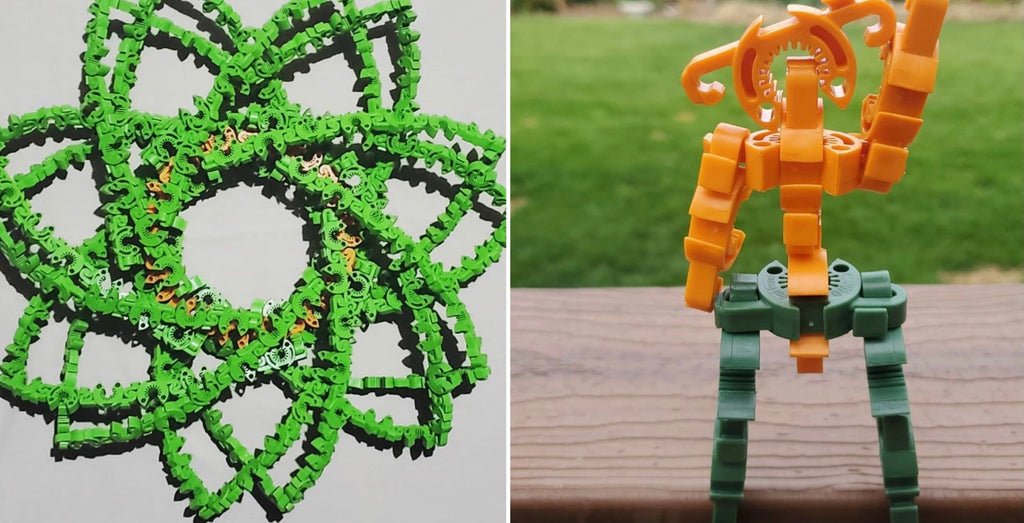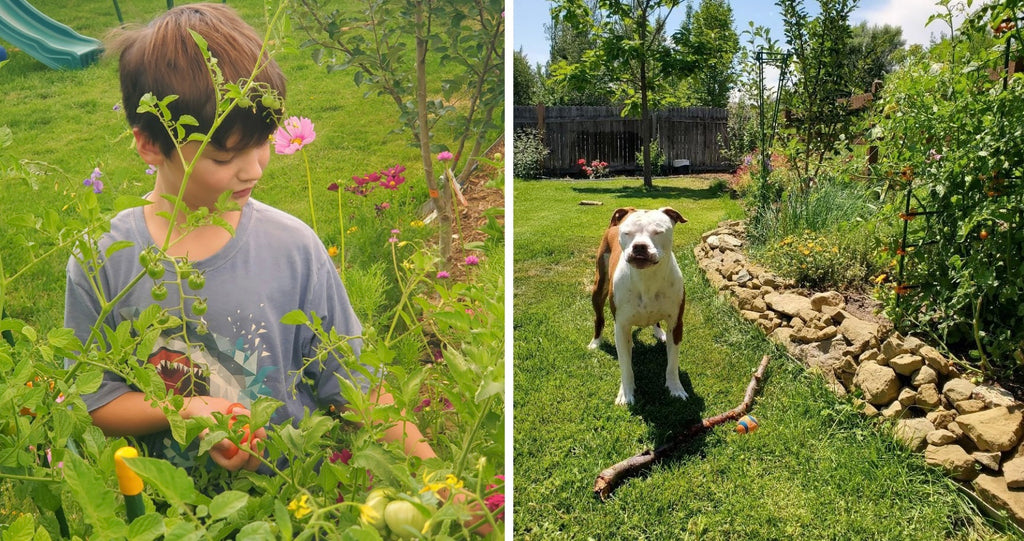Our #GrowInspired series features our innovative and creative garden partners. Whether they’re working with two acres or 200 square feet, we are constantly in awe of their hard work and kick-ass gardens. These are some of our favorite gardens and gardeners who inspire us to get out and play in the dirt.

This week we introduce you to Jason Rider (aka cbite_guy on Instagram) the co-founder of Thriving Design and inventor of the beloved C-BITE clip.
From his professional to personal life, Jason has always been tending to some sort of plant with love. He’s not afraid to have a little fun, either, which is evident in all of the C-BITE creations he’s made out of the sheer joy of building things. We chatted with Jason about the C-BITEs origin story, why he’s so passionate about gardening and some of his tips for growing his favorite plant — cannabis.
The C-BITEs origin story
It all started when I got a 3-D printer in 2004, not with any particular use in mind. The first thing that I designed on it was a c shaped clip that could attach to a stake, with no hooks, no grooves — just a couple of holes and some teeth. I wanted to figure out an easier way to tie off the branches of my cannabis plants to the stakes. Playing around, I discovered that by modifying the part I could get the stakes to fit together. I just kept pushing the envelope until I had the current C-BITE design, which works pretty darn good. It was originally designed to be for cannabis plants, but it works for everything including tomatoes, peas, peonies, cucumbers, or really anything that climbs or tumbles.

I started selling loose C-BITEs in 2015 and by 2017 I’d sold about 500,000, mostly to commercial growers and through distribution with Sunlight Supply and BWGS. I put the business on hold to start a vertical aquaponics basil farm where we had a 5,000 gallon koi tank feeding four stories and 14,000 plant sites where we had herbs and vegetables then went on to build a small, indoor, medical-grade hemp farm that operated up until just a few months ago.

The vertical aquaponics basil farm
After I’d designed the C-BITE, I started thinking about all the other things that I found super useful with how I grow. I sourced the stake caps to help make the jagged stakes safer after you cut them, and our more durable precut plant ties, which are better than anything else on the market. So, with the Thriving Design C-BITE Plant Support Kit, we have a line of gardening products that are extremely helpful to me and other gardeners.

When the patent for his innovative C-BITE (finally) came through in 2019, he asked his sister Morgan to join forces and they started what we all know and love as Thriving Design. The rest — as they say — is history.
On The Many Connections And Out-Of-The-Box Ways Jason Uses C-BITES
Two C-BITEs can fit together to make 49 solid connections. Compare that to two Lego bricks which can fit together 24 solid ways. Once you start using six or more C-BITEs, the combination possibilities are in the trillions.

I use C-BITEs a lot for organizing and running extension cords, I use them to hang my Christmas lights because they clip right on the edge of my awnings, so installation and takedown is super easy. My keys are on them so I can separate the keys to my house and car. I use them to hold drip irrigation tubing. I’ve used them to create plant drying racks, too. I also use them for fun — as toys and for art projects. I’ve made taco holders, towel racks, and a dinosaur.
Jason has made some pretty incredible sculptures using C-BITEs and although we’ve featured some here, you can see more on his Instagram.

On How It Feels To See His Invention In So Many Gardens
It makes me proud to have made something that's of enduring value. To think that other people are going to find ways to use C-BITEs that I’ve never found before? That’s really exciting and satisfying. I like that they’re going to last longer than I will.
On His Love Of Gardening
Gardening has been something I’ve been doing since I was little. Our mom had a garden, and then a friend and I started one and we managed to grow a bunch of vegetables. I've kept the interest going throughout college and into my adult life. My love of gardening is kind of funny because, aside from valuable, productive crops, I just have a love for watching and helping things grow. If I don't eat the produce off of my tomato plants, I couldn’t care less. I am super satisfied when I'm tending to life and taking care of things. It's a great way to spend time outdoors and in the fresh air with my family and my dog. Getting in the dirt is healthy. There's a sense of connectedness with nature that gardening brings about.

On Mission-Driven Work And Gardening
Both [my sister] Morgan and I have always led mission-driven lives. Food security is a major factor in creating a better future and if I can help to do something in that area one way or another, I am happy. The basil farm was a good example of that. I was working in an urban agricultural setting to create high output, low input, foods that could be easily distributed from places that don't have access to those sorts of things, especially perishable herbs. Never in history have so few people fed so many people, and that is a very precarious situation for us, especially when we're not connected to the land. So, you know, the education side, teaching my family and motivating people around me to garden from seed and trying to make it as fun as possible is extremely important.
Aside from my personal satisfaction, I think there's a social value to gardening, like with the Victory Gardens, so much satisfaction and health came out of that. At the same time, the community values that came out of those gardens are the sort of 'things' that we need to emphasize in our own lives. Gardening is a pivotal way for those to occur, especially in urban areas where community gardens should thrive. We’ve already started helping support places like these with donations, education, and media promotion.

Jason's son Kai, left, his dog Dave Barsky, right
On His Outdoor Gardens
I live in the suburbs where I have a smaller, landscaped yard with a compost bin. We started with a blank slate and over the years we’ve planted a variety of trees and with the amended soil from the ground, we've built a few garden beds where we like to grow the real basic things I think my kids will eat and that we enjoy ourselves. We always have tomatoes, lettuce, fresh herbs, and rhubarb, which I’m really excited about, will be ready to harvest next year- so I can make some cakes. We also have roses, honeysuckle and other flowers about — we try to have as much vibrancy and life and green around us as possible. Indoors, we have lots of house plants. So, there’s really just things growing everywhere.

His Favorite Plant to Grow
Cannabis, for sure. It’s so interesting. It’s fast growing, really responsive, and very adaptive. Variation on a single plant based upon conditions changes from harvest to harvest. It’s just a really smart, interesting plant. With growing cannabis, you're doing something that you're going to enjoy down the road. Canning and pickling or brewing is the same kind of thing where you have to follow the right process to make it come out right.
On How He Started Growing Cannabis
I started growing cannabis because it was expensive. First in a closet and then it has expanded outwards. Now I have a pretty nice little six-plant setup that I tend to in Colorado where it's legal (of course). I like the science behind it — the process itself. It’s a lot of time from feeding to harvesting — a true labor of love — and it feels good enjoy my own smoke.

Jason’s Advice For New Cannabis Growers
Listen to smart people. There's been a lot of plant science and research conducting over the last few years since legalization of medical marijuana. These experts know what they’re talking about. It’s not just on dark web forums anymore, like they used to be, but checking out the science and going to the places that manufacture the nutrients and reading on their websites how to do things. But it’s a bit of an art, too, requiring attentiveness and care — spending time with your plants, getting to know them. Noticing them and watching them is really an important part of it.
On His Hopes For Thriving Design In the Future
Of course I would love to see our C-BITEs and Plant Support Kits in lawn and garden centers around the country and the world. But also, I would like to use that platform to continue to advocate for the importance of gardening and growing things.
You can follow Jason on Instagram @cbite_guy.
